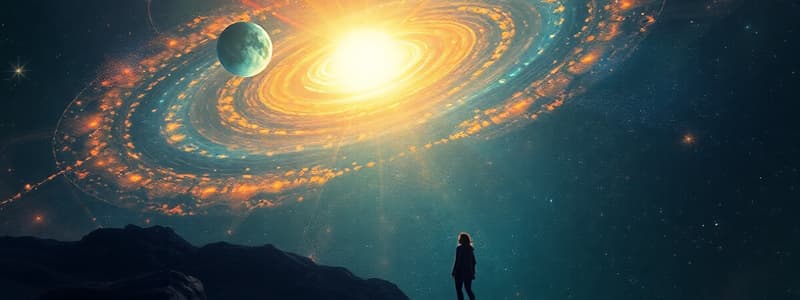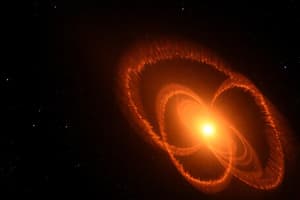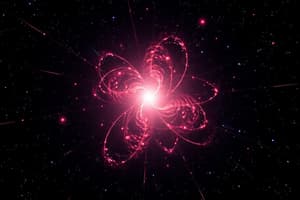Podcast
Questions and Answers
What was the initial working name given to the object that produced the pulsating signals discovered by Jocelyn Bell Burnell?
What was the initial working name given to the object that produced the pulsating signals discovered by Jocelyn Bell Burnell?
Which of the following aspects of Jocelyn Bell Burnell's early life and education was NOT directly referenced in the provided text?
Which of the following aspects of Jocelyn Bell Burnell's early life and education was NOT directly referenced in the provided text?
What is the significance of the discovery of pulsars by Jocelyn Bell Burnell?
What is the significance of the discovery of pulsars by Jocelyn Bell Burnell?
What was the specific period of repetition for the signals detected by Jocelyn Bell Burnell's instruments?
What was the specific period of repetition for the signals detected by Jocelyn Bell Burnell's instruments?
Signup and view all the answers
Which of the following statements accurately reflects the scientific recognition received by Jocelyn Bell Burnell for her discovery of pulsars?
Which of the following statements accurately reflects the scientific recognition received by Jocelyn Bell Burnell for her discovery of pulsars?
Signup and view all the answers
Flashcards
Jocelyn Bell Burnell
Jocelyn Bell Burnell
A pioneering astrophysicist known for discovering pulsars.
Pulsar Discovery Year
Pulsar Discovery Year
In 1967, she observed the first pulsar signals.
LGM-1
LGM-1
Initial name for the pulsar signals, meaning Little Green Men-1.
Dame Commander of the British Empire
Dame Commander of the British Empire
Signup and view all the flashcards
PhD Thesis Focus
PhD Thesis Focus
Signup and view all the flashcards
Study Notes
Jocelyn Bell Burnell
- Born in Belfast, Northern Ireland in 1943
- Developed a passion for science while at boarding school
- Graduated from Glasgow University in 1965
- Pursued a PhD at Cambridge University under Antony Hewish
- Helped design and build radio telescopes to study quasars
- Discovered pulsars in 1967
- Observed radio waves pulsating every 1.337 seconds, originating from specific points in space
- Identified these pulsating waves as originating from rapidly rotating, strongly magnetized neutron stars, which she termed pulsars
- Her work with pulsars was a breakthrough in astrophysics
- Received official recognition in 2007 made a Dame Commander of the British Empire (DBE) for her services to astronomy
Milestones
- Observed a pulsar in 1967
- Her supervisor, Antony Hewish, reported the discovery in Nature the following year
- Received the Nobel Prize in 1974 (though not named in the award)
Studying That Suits You
Use AI to generate personalized quizzes and flashcards to suit your learning preferences.
Description
Explore the remarkable life and achievements of Jocelyn Bell Burnell, the astrophysicist who made groundbreaking discoveries in the study of pulsars. Delve into her education, early career, and the significant impact of her work on modern astronomy. Learn about her recognition and milestones that shaped her legacy.





